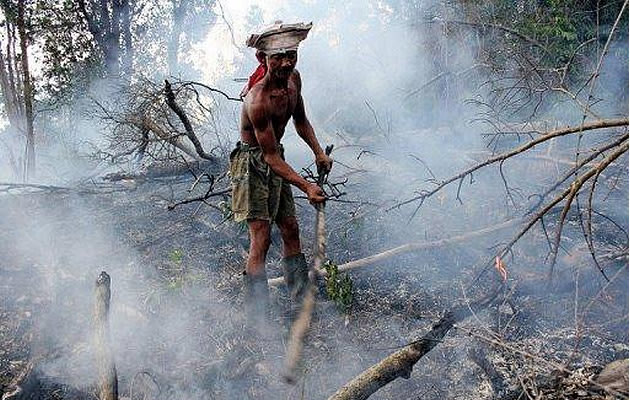Haze could affect Singapore skies: NEA

<cite class="byline vcard" style="font-style: normal; color: rgb(125, 125, 125); font-size: 13px; display: inline-block !important; font-family: Georgia, Times, 'Times New Roman', serif; vertical-align: middle; white-space: nowrap; line-height: 2.2em; ">By Liyana Low | Yahoo! Newsroom</cite>

Indonesian forest fires are the main cause of the annual haze in the region. (AFP file photo)
Singapore may experience slightly hazy conditions as winds blow the smoke haze from Indonesia’s hotspots to the island, said theNational Environment Agency (NEA) on Thursday.
Over the past few days, scattered hotspots with slight to moderate smoke haze have been detected mainly over the central and southern parts of Sumatra.
With the winds over Singapore blowing from the southeast and occasionally from the south, there could be “brief periods of slightly hazy conditions” here should the fires in the region persist, the agency said in a statement on its website.
The impact of the smoke haze is dependent on factors such as the proximity and extent of the fires, the strength and direction of the prevailing winds and the incidence and amount of rain, said NEA.
The announcement comes after parts of Malaysia was covered in haze on Wednesday and Thursday, resulting in poor visibility and relatively bad air quality. Media reports said it was caused by an overnight increase of hotspots from 62 to 120 in Sumatra.
The Southwest Monsoon season from June to September is a traditionally dry season for the southern parts of the Asean region. It is common for haze from forest fires to affect Indonesia's neighbours as winds blow the smoke across geographical boundaries.
Over the last decade in Singapore, the Pollutant Standards Index (PSI), used to measure air quality, has hit the "unhealthy" range -- a reading above 100 -- on three occasions: 1997, 2006 and 2010.
The highest PSI ever recorded here was in 1997 when it reached 226.
The PSI is updated on NEA's website daily at 4pm.

<cite class="byline vcard" style="font-style: normal; color: rgb(125, 125, 125); font-size: 13px; display: inline-block !important; font-family: Georgia, Times, 'Times New Roman', serif; vertical-align: middle; white-space: nowrap; line-height: 2.2em; ">By Liyana Low | Yahoo! Newsroom</cite>

Indonesian forest fires are the main cause of the annual haze in the region. (AFP file photo)
Singapore may experience slightly hazy conditions as winds blow the smoke haze from Indonesia’s hotspots to the island, said theNational Environment Agency (NEA) on Thursday.
Over the past few days, scattered hotspots with slight to moderate smoke haze have been detected mainly over the central and southern parts of Sumatra.
With the winds over Singapore blowing from the southeast and occasionally from the south, there could be “brief periods of slightly hazy conditions” here should the fires in the region persist, the agency said in a statement on its website.
The impact of the smoke haze is dependent on factors such as the proximity and extent of the fires, the strength and direction of the prevailing winds and the incidence and amount of rain, said NEA.
The announcement comes after parts of Malaysia was covered in haze on Wednesday and Thursday, resulting in poor visibility and relatively bad air quality. Media reports said it was caused by an overnight increase of hotspots from 62 to 120 in Sumatra.
The Southwest Monsoon season from June to September is a traditionally dry season for the southern parts of the Asean region. It is common for haze from forest fires to affect Indonesia's neighbours as winds blow the smoke across geographical boundaries.
Over the last decade in Singapore, the Pollutant Standards Index (PSI), used to measure air quality, has hit the "unhealthy" range -- a reading above 100 -- on three occasions: 1997, 2006 and 2010.
The highest PSI ever recorded here was in 1997 when it reached 226.
The PSI is updated on NEA's website daily at 4pm.
